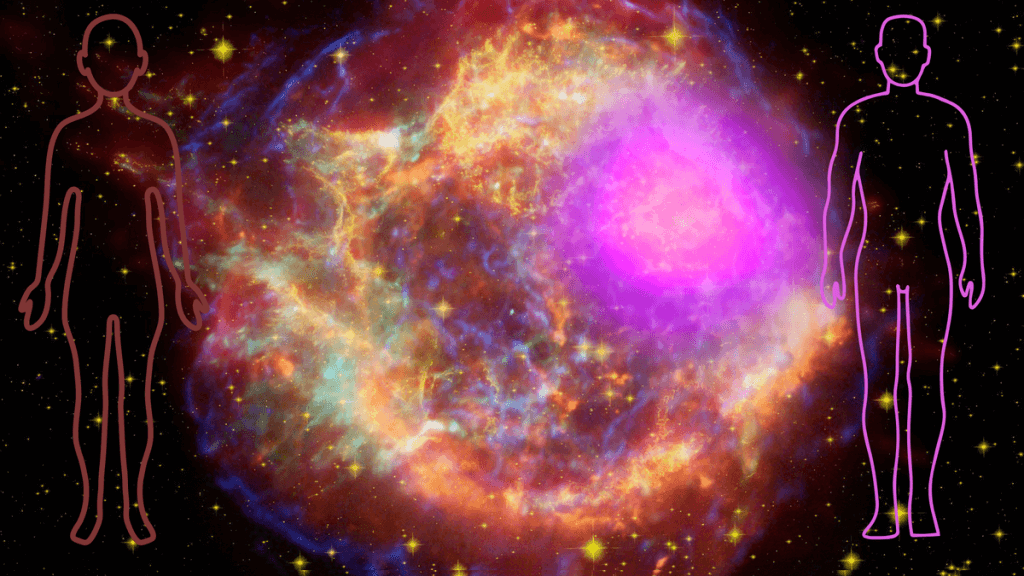
Are we really made of ‘star stuff’ and what does that even mean? (video) (Image Credit: Space.com)
“The cosmos is within us. We are made of star stuff. We are a way for the universe to know itself.” Carl Sagan
During the course of his 1980s mini-series “Cosmos,” astronomer and science communicator Carl Sagan said many inspirational and profound things based on our understanding of the universe. But arguably, none have resonated with the general public more than the statement above.
With this sentiment, Sagan, who passed away in 1996 at the age of 62, was talking about the cosmic origins of humanity.
And in a new video from the European Southern Observatory (ESO), part of the Chasing Starlight series, astrophysicist Suzanna Randall explains what this statement means and how it relates to the elements that comprise our bodies.
Related: How did supermassive black holes get so big so fast just after the Big Bang?

How the universe became more metal
Randall explains that shortly after the Big Bang, the dense and hot universe was comprised mainly of the two lightest elements, hydrogen and helium, as well as a smattering of heavier elements collectively known as metals.
“But, you can’t make up something as complex as the human body of just helium and hydrogen,” she explains. “So, where do the other more complex elements that make up our body and the rest of the universe come from?”
Winding the cosmic clock forward to around 100 million years post-Big Bang, Randall explained that this is when the first nebulas — vast clouds of hydrogen and helium — had formed in the universe. When overly dense regions of these nebulas gathered more and more mass from their surroundings, they eventually collapsed under their own gravity, birthing the first generation of stars.
But, like the universe at that time, these stars were all hydrogen and helium with a negligible amount of metals.
This first generation of stars fused hydrogen in their cores to create helium, something that Randall points out the sun, our 4.6 billion-year-old star, is doing today.
Why did stars have to die for you to live?
This all means that, at the time when the first stars existed, the universe still didn’t have enough heavy elements needed to form our bodies like nitrogen, oxygen and carbon.
But this changed as the first generation of stars began to die.
“When the hydrogen in the core of the star has been used up, things start happening very quickly,” Randall says. “The star enters a new phase of its life, called the red giant phase.”
During the red giant phase, the cores of these first stars would have contracted. Meanwhile, their outer layers, where the nuclear fusion of hydrogen to helium was still taking place, would have puffed out and increased the stars’ sizes by as much as 100 times. The core would’ve continued to contract until conditions at the hearts of the stars, which would’ve been much more massive than the sun, became hot and dense enough to start fusing helium into heavier elements. And there, elements like carbon and oxygen, which comprise around 84% of our bodies, spawned into existence.
“The majority of the atoms in my body are actually created deep inside stars in these incredibly hot stellar furnaces,” Randall explained.
The universe finally got the “stuff” needed for life, but that stuff wasn’t of much use locked in the hearts of red giant stars. Don’t worry, though, these elements wouldn’t stay confined for long — not in cosmic terms, anyway.
“Stars with more than about eight solar masses continue to fuse elements in their core, and they create heavier and heavier elements — as heavy as iron,” Randall said. “At some point, they have to die, and they go out with a bang. They explode as supernovae.”
During those cosmic explosions, Randall says some astronomers believe even heavier elements, like gold or platinum, had formed. However, other scientists think it would’ve had to take the collision of two stellar corpses, called neutron stars, and therefore a kilonova explosion to create such precious elements.
What is certain about the supernova explosions of the universe’s first stars is they took all the elements forged by these stars during their lives and flung them out into the cosmos.
Eventually, these elements were integrated into nebulas and thus became part of the next generation of stars born from those vast dust clouds.
That means this next generation of stars was more “metal-rich” than the preceding generation. This continued through to the creation of the third generation of stars, one of which is the sun.
Enriched material from the nebula that created the sun, but didn’t manage to become part of our star 4.6 billion years ago, then formed a disk of material around the stellar body called a protoplanetary disk.
As the name implies, it is from this disk of material that the planets of the solar system, including Earth, formed. And it is from this disk that the elements that make up our bodies are derived.
“As it turns out, Carl Sagan was right. We are literally made up of star stuff,” Randall said. “And the story of stars in their lives is also the story of the elements that make up our body. We’re all part of this grand cosmic cycle.”
As the astrophysicist points out, however, we maybe shouldn’t let this go to our heads too much. As an ego-cleanser, Randall concludes by adding: “Before you get too excited, cockroaches are also made up of star stuff.”





